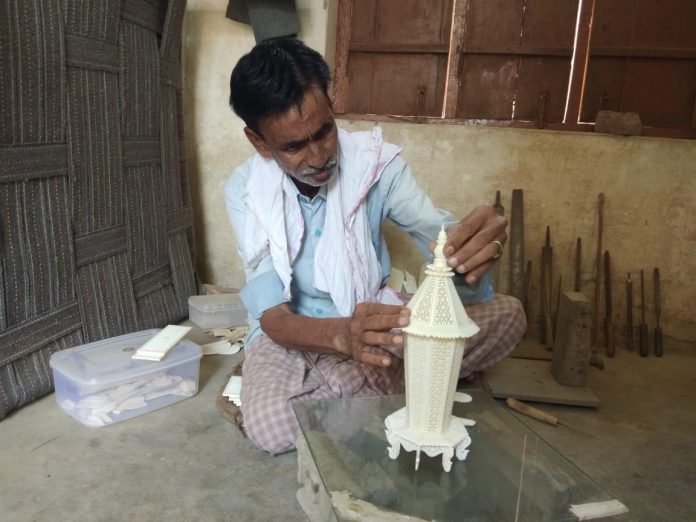
Over-400-year-old bone carving trade in UP has been hit hard by the government’s crackdown on illegal slaughter houses.
A Tripathi | TwoCircles.net
UTTAR PRADESH — Abrar Ahmed, a bone carver in Barabanki’s Maila Raiganj village never had imagined that centuries old bone carving trade—that got maximum patronage during the Nawabi era when it used ivory tusks—would end abruptly. Ahmed blamed BJP Government’s “anti-meat approach” which acted as the last nail in its coffin, bringing thousands of families engaged in the trade, hand to mouth.
Ahmed, a recipient of the President award, is now jobless. “I’ve done this for 40 years. I never thought of any other trade, nor bothered to learn any other skill. And now when I am jobless, I don’t have any way out,” Ahmed told TwoCircles.net.
The situation of more than 100 families in his village is similar.“Ours used to be the village of ustads (master craftsmen) who were known for their fine bone art. But now they are doing odd jobs,” said Ahmed.
Other than Barabanki that was known for its fine bone artwork, the bone artists in Lucknow, Ghaziabad, Bareilly and Moradabad too got affected.
The downfall
Bone carvers in Barabanki said that the trade’s downfall began in 2017 when the BJP government first came into power in Uttar Pradesh. “To implement the National Green Tribunal’s order, the authorities launched a crackdown on slaughter houses that didn’t comply with pollution control norms. “There was nothing wrong with the order. In fact we too are in favour of keeping a check on illegal slaughter houses. But gradually, they also targeted government-run-slaughter houses which used to be the main source of bones” said Mohammed Jalaludddin, a bone carver in Hussainabad, Lucknow.
Bone of contention
“We want to know why the government-run slaughter houses were not upgraded? Also, if they wanted to comply with the order, they should have made alternative arrangements to ensure that the supply of meat and bones remained uninterrupted,” said Israr Ahmed, a President-awardee bone carver in Lucknow.
Inflation, a double whammy
In the bone carving trade, the carving is carried out only on the femur bones. And in one animal, there are four femur bones that can be used for the bone carving purpose. “The less availability of bones pushed up the bone prices. The bone that used to cost Rs 2-3 per kg is now worth 45 Rs per kg.
According to historians, the bone carving was introduced during the Nawabi era when it used to be carried out on the ivory tusk. “However after the Indian Government imposed a ban on the use of tusks, the bone carvers found an alternative and they started doing bone carving on buffalo and camel bones for their survival. Lucknow and the neighbouring districts used to be the main hub for bone carving,” said Roshan Taqui, a Lucknow-based historian.
The maintenance of slaughter houses comes under the purview of the Food Safety and Drug Administration (FSDA) department but the officials here seemed least bothered in bringing change to the grim picture.
“We are the licensing authority. So far no agency has approached us regarding setting up of new slaughterhouses,” said VK Verma, assistant commissioner (food), FSDA.

